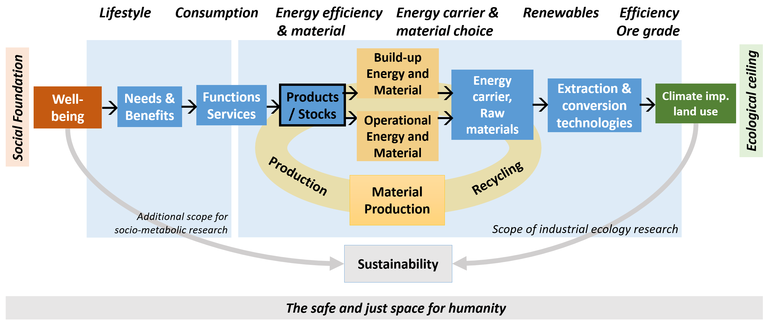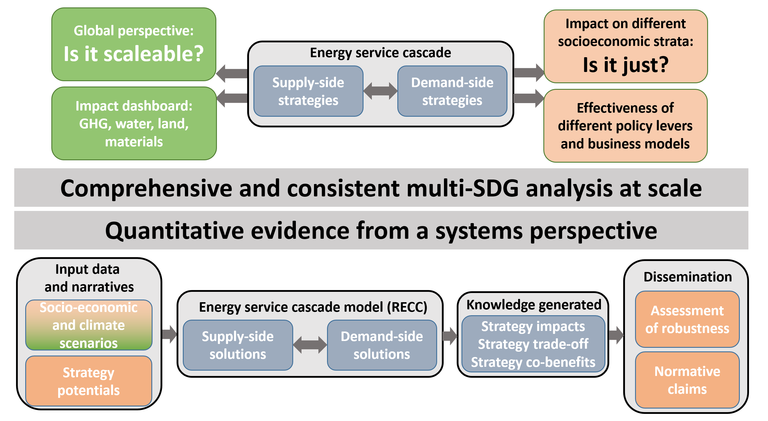Research
Human activities such as housing, transportation or education require a certain number of buildings and vehicles as well as infrastructure. The production of these so-called in-use stocks requires large amounts of materials and energy, such as cement, steel, wood or electricity, the provision of which in turn leads to significant climate and environmental impacts. With our research, we strive to find out what quantities of materials and energy can be provided sustainably and how these quantities can be used to generate maximal benefit for society.
The main tool for our research is scenario modeling. First, fundamental assumptions are made about future population development and the demand for various activities. Then, with the help of a mathematical model and a precise description of lifestyles, legal regulations, prices and technologies, it is determined which energy and material flows are required for the provision of the activities, which savings potentials exist through efficiency, recycling (circular economy) and alternative lifestyles, and which global environmental impacts result from this. The scenarios will show which consumption patterns are consistent with the various Sustainable Development Goals and which are not. For these scenario analyses of consumption, production and recycling at the regional, country and global levels, we compile extensive data and further develop the calculation methods and models. As a preliminary stage of scenario analysis, we determine the global environmental footprint of individual building types, vehicles and lifestyles, and aim to understand how cities can be designed to be resource efficient. We are also developing new methods and models for this analysis.
The findings obtained from the scenario analysis provide a detailed insight into a sustainable economy under planetary ecological boundaries. Our model results highlight the possibilities, but also the limitations, of individual strategies and make it clear that there must be a very broad spectrum of sustainability strategies implemented simultaneously in order to achieve the United Nations' key sustainable development goals. These systemic insights into the sustainability transformation are highly relevant for policy makers and decision-makers in businesses, for non-governmental organizations such as environmental associations, and for the general public.
Below, we describe our research approach in detail and highlight some key findings from our research in recent years. We also maintain a research portal with a blog, a database of our research results, information on our models, extensive educational material, and interactive visualization tools. The publications of the members of the Industrial Ecology Freiburg working group are available via the respective links to Google Scholar on our team page. Open positions are published on the job board of the International Society for Industrial Ecology.
The Energy Service Cascade - A cascade of opportunities to decouple human well-being from harmful environmental impacts: A sustainable economy meets society's needs while respecting planetary ecological boundaries. There are several stages between human well-being and the environmental impacts of industrial production (Figure 1). Activities such as housing, transportation, or education are major contributors to human wellbeing. These activities require inventories of buildings, vehicles, and infrastructure that must be constructed, maintained, and operated. Construction, maintenance, and operation require flows of materials and energy, the production of which carries significant climate and environmental impacts. At the same time, recycling materials from end-of-life products that are no longer needed offers the opportunity to save energy and raw materials. Together, these stages form what is known as the energy service cascade.
A wide variety of strategies are integrated here - from alternative urban and rural lifestyles to durable and lightweight products to renewable energy sources. Each of the stages in the cascade represents an opportunity to decouple human well-being from harmful environmental impacts, i.e., to achieve more well-being with less resource use.

Figure 1: The cascade of services/consumption, product stocks, material production, energy supply, and environmental impacts. Adapted from Kalt et al. (2019).
Development of scenarios for the energy service cascade: Our scenario models provide a consistent and detailed description of the individual stages of the energy-service cascade, including various demand and production scenarios. First, we model exactly how the assets (cars, buildings) are used, the energy and material flows required to build and operate them, the recycling potential, and the resulting social benefits and environmental impacts (Figure 2). Here, data and findings from other sciences such as social sciences, economics, and engineering are incorporated. Second, various policy instruments, such as taxes, subsidies, or regulations/regulation, are examined for their effectiveness and interaction with other strategies. Finally, questions of scalability are addressed, i.e. how individual strategies affect different social strata and what effects could be expected in the case of global upscaling.

Figure 2: Schematic drawing of the model approach for scenario analysis of different consumption and production strategies in the energy and material service cascade.
Examples of our research:
Material Requirements of Decent Living Standards
Decent living standards (DLS) provide a framework to estimate a practical threshold for the energy, GHG, and material consumption required to alleviate poverty. Dr. Johan Vélez quantified the amount of materials in stocks and flows needed to provide a DLS, and finds that a material footprint (MF) of about 6 t/(cap*yr) and in-use stocks of about 43 t/cap are required. Nutrition (39%) and mobility (26%) contribute the most to total MF. Buildings and infrastructure account for the largest share of in-use stocks.
Read the publication (Vélez and Pauliuk 2023) here: https://doi.org/10.1021/acs.est.3c03957
Resource and Emission Savings from Material Efficiency
Material production accounts for a quarter of global greenhouse gas (GHG) emissions. We present a global-scale analysis of material efficiency for passenger vehicles and residential buildings. We estimate future changes in material flows and energy use due to increased yields, light design, material substitution, extended service life, and increased service efficiency, reuse, and recycling. Together, these strategies can reduce cumulative global GHG emissions until 2050 by 20–52 Gt CO2-eq (residential buildings) and 13–26 Gt CO2e-eq (passenger vehicles), depending on policy assumptions. Next to energy efficiency and low-carbon energy supply, material efficiency is the third pillar of deep decarbonization for these sectors.
Read the publication (Pauliuk et al. 2021) here: https://doi.org/10.1038/s41467-021-25300-4
Image source: IRP (2020). Resource Efficiency and Climate Change: Material Efficiency Strategies for a Low-Carbon Future. Hertwich, E., Lifset, R., Pauliuk, S., Heeren, N. A report of the International Resource Panel. United Nations Environment Programme, Nairobi, Kenya.
Intensive or Extensive Forestry?
Forestry plays a major role in climate change mitigation. However, which intensity of logging is best suited for that task remains controversial. We assess whether increased carbon storage in wood products and substitution of other emission-intensive materials can offset reduced carbon stocks in the forest due to increased harvesting. For that, we calculate annual required displacement factors (RDF)—a dimensionless quantity that indicates the minimal displacement factor (DF) so that intensive forestry outperforms extensive forestry from a climate perspective. Our results indicate that the extrapolation of current harvest rates reflects an effective compromise between carbon stocks in the forest and carbon displacement by wood use.
Read the publication (Buschbeck and Pauliuk 2022) here: https://doi.org/10.1186/s13021-022-00216-8

